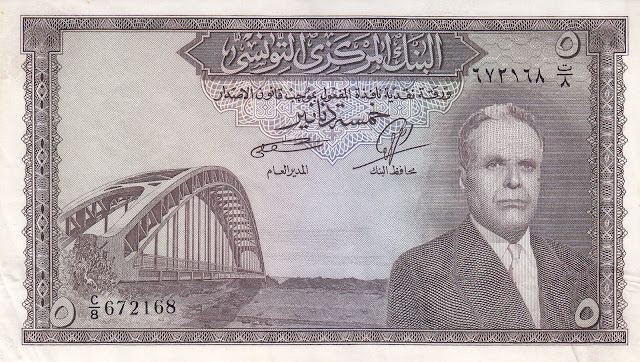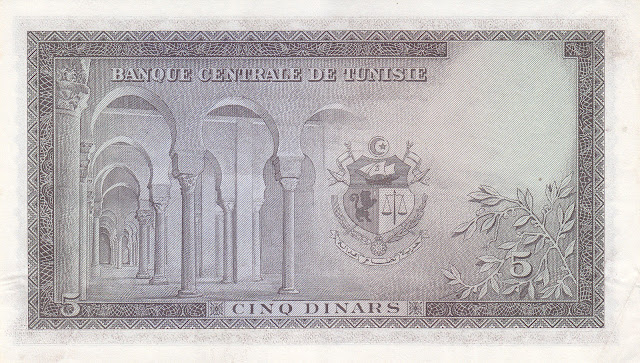Tunisia Banknotes 5 Dinars banknote 1958 President Habib Bourguiba
Central Bank of Tunisia - Banque Centrale de Tunisie
Obverse: Portrait of Habib Bourguiba (full name: Habib Ben Ali Bourguiba; 1903 – 2000) was a Tunisian statesman who became the country's first President of the Republic of Tunisia from 1957 to 1987. Bridge across Mellegue River at left. The note denomination is indicated in arabic figures and letters.
Reverse: Columns and arches of the portico of the courtyard and the secondary naves of the prayer hall at the Great Mosque of Kairouan, also known as the Mosque of Uqba. The coat of arms of the Republic of Tunisia 1957-1963 displays a Punic galley (symbol of freedom) along with a lion holding a sword (symbol of order), and a weighing scale (symbol of justice). A branch of olive-tree, symbol of peace and tunisian agriculture at right.
Watermark: Coat of arms of Tunisia.
Signatures: Mansour Moalla (Le Directeur Général); Hedi Amara Nouira (Le Gouverneur).
Predominant colour: Violet-brown.
Issuer: Central Bank of Tunisia.
Date of issue: 3 November 1958.
Date of withdrawal: 28 May 1962.
Dimensions: 163 x 93 mm.
Printer Bradbury Wilkinson and Company, London England.
Texts: Banque Centrale de Tunisie. Central Bank of the Republic of Tunisia. Cinq Dinars. Five Dinars.
Tunisia Banknotes - Tunisia Paper Money
1958 Issue
Half Dinar 1 Dinar 5 Dinars
Great Mosque of Kairouan
The Great Mosque of Kairouan, also known as the Mosque of Uqba, is one of the most important mosques in Tunisia, situated in the UNESCO World Heritage town of Kairouan.
Established by the Arab general Uqba ibn Nafi in 670 AD (the year 50 according to the Islamic calendar) at the founding of the city of Kairouan, the mosque is spread over a surface area of 9,000 square metres and it is one of the oldest places of worship in the Islamic world, as well as a model for all later mosques in the Maghreb. The Great Mosque of Kairouan is one of the most impressive and largest Islamic monuments in North Africa, its perimeter is almost equal to 405 metres (1,328 feet). This vast space contains a hypostyle prayer hall, a huge marble-paved courtyard and a massive square minaret. In addition to its spiritual prestige, the Mosque of Uqba is one of the masterpieces of both architecture and Islamic art.
Under the Aghlabids (9th century), huge works gave the mosque its present aspect. The fame of the Mosque of Uqba and of the other holy sites at Kairouan helped the city to develop and repopulate increasingly. The university, consisting of scholars who taught in the mosque, was a centre of education both in Islamic thought and in the secular sciences. Its role can be compared to that of the University of Paris in the Middle Ages. With the decline of the city of Kairouan from the mid 11th century, the centre of intellectual thought moved to the University of Ez-Zitouna in Tunis.

